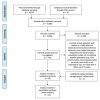Frequency of Pregnancy-Associated Cancer: A Systematic Review of Population-Based Studies
- PMID: 32466494
- PMCID: PMC7352408
- DOI: 10.3390/cancers12061356
Frequency of Pregnancy-Associated Cancer: A Systematic Review of Population-Based Studies
Abstract
Despite numerous available resources of evidence, the results about the frequency of pregnancy-associated cancer (PAC) still show poor comparability due to dissimilarities in the study design and methodology, inclusion criteria, incoherent duration of follow-up and a heterogeneous reference population. We conducted a systematic review of population-based studies on PAC published up to December 2019, to provide updated research on this topic, highlighting strengths and limitations. Of the 24 papers included, 11 considered all types of tumors and 13 dealt with specific types of cancer. Differences in the procedures for estimating the frequency of PAC emerged even among population studies. However, we found consistent results for overall frequency of PAC- around 1/1000 pregnancies. Our review suggests that about 25% of PAC cases are diagnosed during pregnancy, confirming the hypothesis of an excess of diagnosis in the postpregnancy period. Sparse and inconsistent results were found regarding a potential increase in the frequency of PAC over calendar years. Alignments in the strategy to identify PAC are needed to overcome methodological weaknesses.
Keywords: cancer; frequency; population-study; pregnancy.
Conflict of interest statement
The authors declare no conflict of interest.
Figures
References
-
- Cardonick E. Cancer occurs in approximately 1 per 1,000 pregnancies. Oncology (Williston Park. N. Y.) 2008;22:22–23. - PubMed



